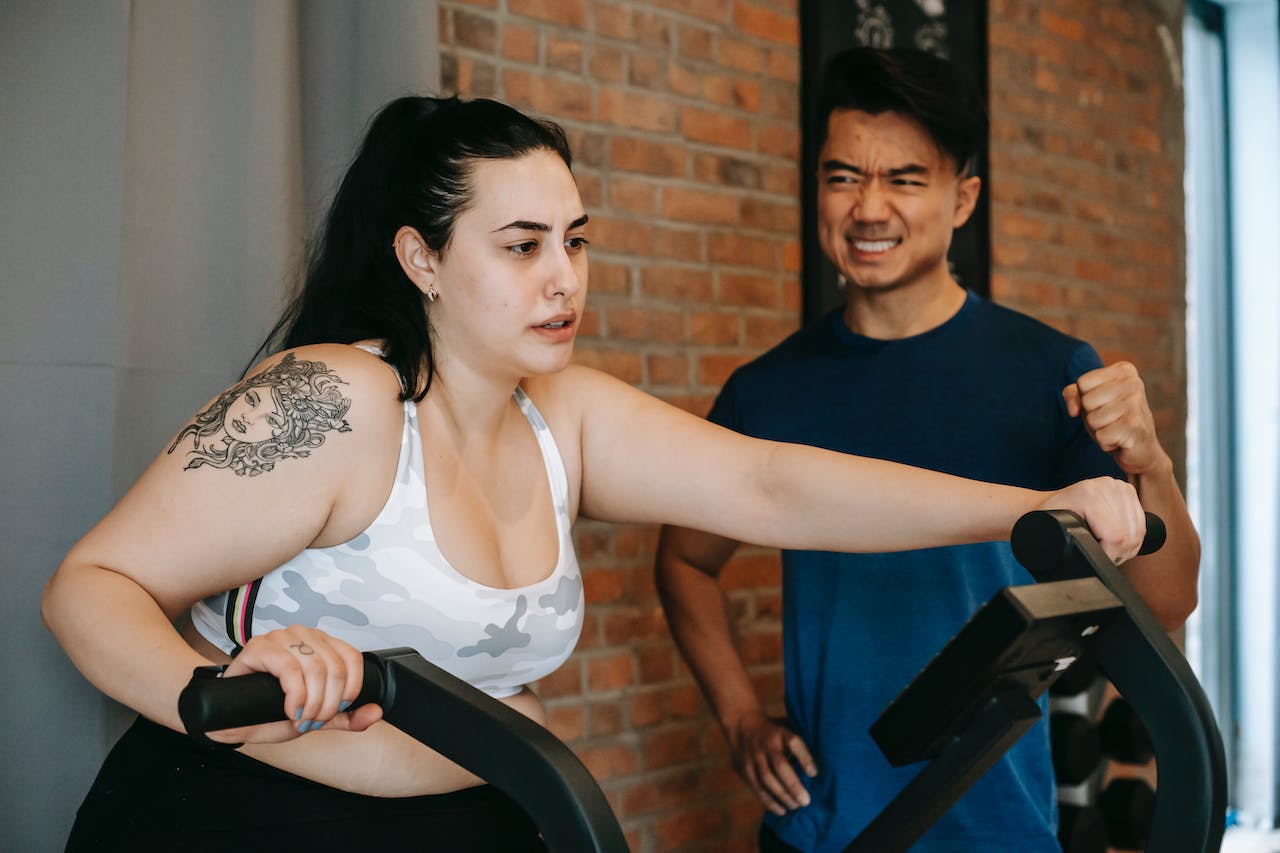A meaningful profession awaits in personal training, where dedication and know-how come together to make a real difference in people’s lives. To become a personal trainer, you’ll need a clear plan to navigate the challenges ahead. This guide aims to offer you a straightforward path, giving you advice and direction as you strive to become a knowledgeable and influential fitness coach.
Self-Assessment and Passion Exploration
Before embarking on your journey as a personal trainer, take a moment to introspect and assess your fitness journey. Reflect on what initially drew you to the fitness world and identify your strengths, weaknesses, and areas of interest. Consider your experiences with exercise, whether it’s overcoming fitness obstacles, achieving personal goals, or simply finding joy in physical activity.
Understanding your passion for fitness will fuel your motivation and guide your career path as you seek to inspire and empower others on their fitness journeys.
Educational Requirements
To become a personal trainer, you must complete your high school education. Most certifying organizations require a high school diploma or the equivalent before being eligible for certification. While high school graduation is enough, post-secondary classes and training are lovely.
Obtaining the necessary education and certifications is paramount to establishing yourself as a credible and competent personal trainer. Research reputable organizations such as NASM (National Academy of Sports Medicine) or ACE (American Council on Exercise) and ensure that their certification programs are accredited by respected bodies like the NCCA (National Commission for Certifying Agencies).
Dedicate time and effort to thoroughly prepare for certification exams, as they benchmark your knowledge and proficiency in the field. Investing in your education early on will provide you with a solid foundation to build your career as a personal trainer.
Get Certified in AED/CPR
Knowing what to do while assisting a client who is hurt or experiencing a medical emergency is crucial. That’s why being certified in AED and CPR is vital to being a certified personal trainer. After completing these courses, you will be able to recognize medical emergencies and know what to do if you need to treat a patient until emergency medical assistance comes. This includes instances of a heart attack if a client stops breathing or if there is any other kind of injury. Also, owning one after being certified is crucial, so check out a comparison of the best AEDs.
Choose Your Specialization
Personal training encompasses various specialties, each catering to specific fitness goals and demographics. Take the time to explore different areas such as weight loss, strength training, corrective exercise, or sports performance, and consider which aligns best with your interests, strengths, and career goals.
Once you’ve identified your niche, consider pursuing additional certifications or continuing education courses to deepen your expertise. Specializing in a particular niche allows you to differentiate yourself in the market and better serve your clients’ needs.
Get Ready for Certification
Generally speaking, deciding you want to get certified and take the test isn’t practical. Instead, there will be classes you’ll need to take and training you’ll need to participate in to help you prepare to be certified. These vary depending on where you’ve chosen to be approved. Personal trainers can obtain certification from the American Council on Exercise and the National Academy of Sports Medicine.
Take the Exam
You’ll need to register for the exam once you’re ready to take it. Typically, this entails completing an application and paying a charge. Many of these certification tests are done online and involve answering up to 150 multiple-choice questions. The tests cover several topics and encompass many parts of being a personal trainer, from kinesiology to the job’s safety and client interaction aspects. Because the test covers so much material, it’s highly recommended to do plenty of studying and preparation before attempting to take the exam. You can retake it if you don’t pass, but you must pay the fee and apply again each time you take it.
Gain Practical Experience
While theoretical knowledge is essential, practical experience is invaluable in personal training. Seek opportunities to gain hands-on experience by interning or shadowing experienced trainers at gyms, fitness centers, or rehabilitation facilities.
Immersing yourself in real-world training settings will provide invaluable insights into client interaction, program design, and the day-to-day responsibilities of a personal trainer. Embrace every opportunity to learn from seasoned professionals and apply your knowledge in a practical setting, as it will ultimately shape you into a more competent and confident trainer.
Build a Strong Network
Networking is a vital component of success in the personal training industry. Connect with fellow fitness professionals, industry experts, and potential mentors through networking events, workshops, and online communities. Building strong relationships within the fitness community provides valuable support and guidance and opens doors to potential job opportunities, collaborations, and referrals. Seek mentors who can offer advice, share their experiences, and help you navigate the challenges and opportunities of your career as a personal trainer.
Obtain Necessary Business Skills
In addition to fitness expertise, personal trainers must possess essential business skills to thrive in the industry. Familiarize yourself with marketing, sales, customer service, and financial management basics to effectively establish and grow your personal training business. Consider investing in business courses, workshops, or mentorship programs to develop your entrepreneurial skills further and ensure your business’s long-term success.
By mastering these fundamental business skills, you’ll be better equipped to attract and retain clients, manage your finances, and navigate the complexities of running a personal training business.
Continuing Education and Professional Development
The fitness industry constantly evolves, with new research, trends, and techniques emerging regularly. Commit to lifelong learning and professional development to stay current and competitive in the field. Attend workshops, seminars, conferences, and online courses to expand your knowledge, skills, and expertise.
Consider pursuing advanced certifications, specialization courses, or additional qualifications to differentiate yourself further and enhance your value as a personal trainer. By staying abreast of industry trends and continuously expanding your skill set, you’ll be better equipped to meet the evolving needs of your clients and maintain your competitive edge in the market.
Maintain Certification and Insurance
Once you’ve obtained your initial certification, it’s essential to maintain it through ongoing education and renewal requirements. Stay informed about changes in certification standards, requirements, and regulations to ensure you remain compliant and up-to-date with industry best practices.
Additionally, obtaining liability insurance is essential to protect yourself and your clients from potential risks, accidents, or legal liabilities. Consider working with an insurance provider specializing in fitness professionals to find a policy that meets your needs and provides comprehensive coverage. By maintaining your certification and insurance, you’ll demonstrate your commitment to professionalism, safety, and quality of service to your clients.
Provide Exceptional Service
Success as a personal trainer hinges on the quality of service you provide to your clients. Focus on building strong, trusting relationships with your clients based on mutual respect, communication, and empathy. Take the time to understand their individual needs, goals, preferences, and limitations, and tailor your training programs accordingly. Strive to exceed their expectations by delivering personalized, results-oriented training programs, providing ongoing support, motivation, and accountability, and adapting your approach to ensure their success.
By prioritizing the needs and well-being of your clients, you’ll not only help them achieve their fitness goals and build a loyal client base and a reputation as a trusted, reliable, and effective personal trainer.
Stay Committed and Flexible
Becoming a successful personal trainer requires dedication, perseverance, and adaptability. Embrace challenges as opportunities for growth and learning, and remain committed to your long-term goals and aspirations. Stay flexible and open-minded in your approach, as the fitness industry constantly evolves, with new trends, technologies, and opportunities emerging regularly.
By staying proactive, curious, and adaptable, you’ll be better equipped to navigate the ever-changing landscape of the fitness industry, seize new opportunities for growth and development, and continue to thrive as a successful personal trainer.
Conclusion
As you reach the end of this guide, remember that dedication, passion, and ongoing learning are essential for success as a personal trainer. Being a personal trainer is a rewarding and fulfilling career many people love. Embrace challenges, stay adaptable, and prioritize the needs of your clients. With perseverance and a commitment to excellence, you have the potential to thrive in this rewarding profession. Good luck on your journey!





